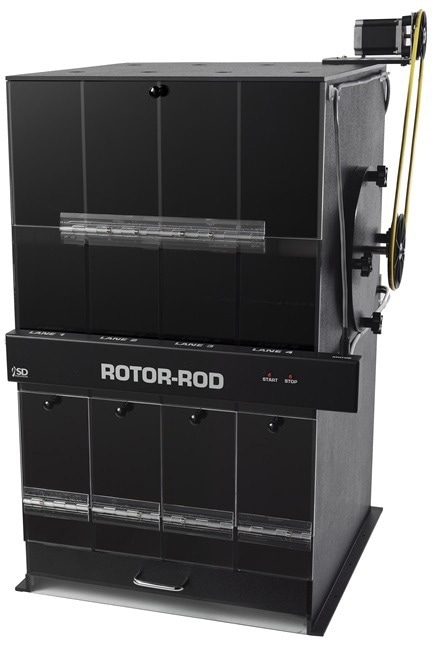The Rotor Rod system enables the examination of motor coordination by utilizing the innate fear of falling, ensuring consistent and precise results.
The ROTOR-ROD™ system by SDI leverages this natural response, minimizing interference from external stimuli. Unlike other systems, it provides an extended range of falling heights and incorporates strategically positioned photobeams to reduce the likelihood of false falls.
This rotarod test is available in three sizes to accommodate mice, rats, or both. It allows the user to predefine all study sessions in advance, saving time and ensuring maximum accuracy.

Image Credit: San Diego Instruments, Inc.
Features
- Automatically tracks fall latencies, distances traveled, and RPM at the moment of fall
- Enhance rotarod testing with programmable acceleration, constant speed, and deceleration, eliminating fixed acceleration limitations
- The secured enclosure ensures that animals cannot escape after a safe landing.
- Interchangeable rods accommodate both mice and rats
- Adjustable falling heights range from 18 to 48 inches
Description
The Rotor-Rod system assesses motor function, learning, coordination, and equilibrium in rats and mice. The Rotor-Rod software allows users to design their own speed control ramp. The system includes adjustable falling heights ranging from 18 to 48 inches, leveraging the "fear of falling" instinct as a natural motivator.
Rotor-Rod is available in three configurations: one for mice, one for rats, and a combined model for both species. Each model features four independently timed lanes that automatically record latencies, distance traveled, and RPM at the time of fall. Secured enclosures prevent the subjects from escaping after landing safely.
SDI’s Rota Rod system highlights
Reliable latency times ensured with a natural stimulus
The fear of falling is a natural stimulus, ensuring consistent latency times. By utilizing this motivation alone, the animals remain on the running rod without the risk of interference from external stimuli affecting the rotarod apparatus. In the rotarod system, the falling height is fixed at 18 inches for mice, while it is adjustable up to 48 inches for rats.
Run up to four animals simultaneously yet independently
The SDI Rotor-Rod test allows testing up to four animals simultaneously for enhanced flexibility. To perform concurrent testing, place one to four animals in individual lanes within the enclosure. Once all photo beams are broken, the rod will automatically stop rotating. The maximum test duration can also be programmed to halt the rod, even if not all animals have fallen.
No false falls
Each lane features seven strategically placed photobeams beneath the running rod, ensuring only genuine falls are recorded. When an animal falls from the rotor rod treadmill, the photobeams capture latency to the fall and the distance traveled. Unlike some systems, no fall is recorded if the animal clings to the rod and moves around it.
Prevent animal escape
Animal collection is simple after tests are completed, as the fully enclosed compartments prevent escape following a fall.
Rotor Rod software
Achieve optimal flexibility and accuracy with the ROTOR-ROD software. Begin by defining the entire study in advance, pre-assigning specific animals to designated lanes for each test session, and assigning a predefined Ramp Profile to each session. The software automatically records the session data and stores it in a single study file, ensuring all data is centralized. When ready, users can display the data directly on the computer monitor or easily export it with a single click to Microsoft® Excel or a delimited file type (TAB, CSV, etc.).
Ensure accurate session results with saved ramp profiles
Create custom Ramp Profiles for rotarod speed by combining acceleration, constant speed, and deceleration steps in any sequence. To streamline future tests and ensure consistent replication, save these Ramp Profiles for reuse in subsequent sessions.
Define the study in advance
Accurate data collection is achieved by defining each test session in advance. Session parameters can be planned, subject identifiers assigned, and specific subjects allocated to designated test stations. Additional parameters, such as dose levels, can also be specified. All critical data is securely stored in a single file format, preventing data loss.
Automatically run sessions
Defining studies saves time by automating sessions and reduces errors from real-time decisions and manual data entry. This approach ensures results are precisely linked to predefined subject identifiers. To run a session, simply follow the ROTOR-ROD™ software’s step-by-step instructions.
Export directly to Microsoft® Excel (or any delimited file type)
The ROTOR-ROD™ software provides table-formatted results that can be directly exported to Microsoft® Excel or various delimited file types (TAB, CSV, etc.), with data automatically organized by column headers. Exporting from a single file eliminates the risk of losing critical information and saves time by removing the need to consolidate multiple files or reformat data.
System components include:
- Optional rotarod rat cart increases falling distance up to 48 inches
- User Manual
- Enclosures with four independently timed lanes
- Photobeams
- Software
- All cables and connectors
Specifications
- Lane Dimensions: 4.5″ (W) per animal
- Outside Dimensions: 66” (H) × 36” (W) × 24” (D) (rotarod rat); 33” (H) × 36” (W) × 24” (D) (rotarod mouse)
- Rod Diameter: 1.25″ (rotarod mouse); 2.75″ (rotarod rat)
- Fall Height: 18” for mice, 48” for rats
- Maximum # of Stations: 4 animal compartments
- Material Composition: ABS with acrylic windows
- # of Photobeams: 7 per lane, 28 total
- Photobeam Spacing: 0.5″
- Speed Range: 0 to 50 RPM